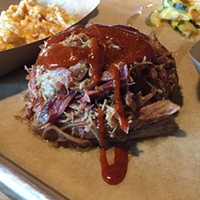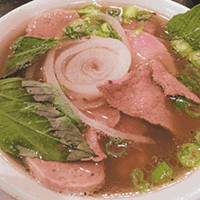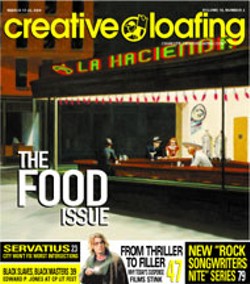Page 2 of 3
One of the best benefits of Charlotte's expanding Latino community is the reemergence of a local meat market where cuts are sold in the weight the customer desires and in the cut the customer wants.
What other culinary benefits will Charlotte achieve from its booming Latino presence? Not all Latin American cuisine is the same. Nor is it all Mexican. Latin America has a mix of Old World and New World: indigenous foods, flavors, and preparation styles of the native people and the imported foods and style from the European folks who "discovered" them.
Mexican cuisine is the new darling of American culinarians, with celebrity Chicago-based chef Rick Bayless leading the charge. Mexican food is complex and deeply rooted in the indigenous cuisine of Native Americans; scores of chilies provide the flavor base while corn and beans are the staples. In the 1500s, the Spanish introduced pigs, cows, and chickens into the mix. Most of true Mexican cuisine consists of long, slowly simmered dishes that emanate layers of flavors; in Mexico, tacos and enchiladas are snack foods similar to what a hot dog is in the US.
Throughout the countries to the south of the US, food is part of the cultural identity, part of who they are. Mexicans who come to Charlotte may be looking for economic opportunity, but when it comes to their stomachs, they want their homegrown comfort food. Since many come from farm communities, they are used to simple, but extremely fresh foods. This is why so many taquerias in Charlotte have opened to serve, almost exclusively, the local Mexican and Central American population. The Latino upper and middle socio-economic classes, on the other hand, identify more with their European roots.
To place all Latino food under one umbrella is a pretty tall order. South American food is distinctly different from Caribbean, Mexican, and Central American food. In South America, the cuisines are as divergent as the climate. Tropical fruits and fish dominate menus in the north while meats, especially beef, are popular in the south. Foods from the Caribbean nation of the Dominican Republic are a creative Creole mix of Spanish, French, and African cooking techniques using indigenous produce and seafood to produce such dishes as shrimp and mashed potato balls with chipotle peppers, cilantro, and mango-pineapple salsa, and fricassee de pollo, a chicken dish made with lime, peppers, onions, bacon, and carrots. Some differences are subtle: the Guatemalan tamale is wrapped in a plantain leaf, not a corn husk.
But the biggest differences we see in the Latino food outlets in Charlotte are the socio-economic classes of people. Many South Americans, such as the Colombians and Venezuelans, who come to Charlotte are highly educated middle or upper class, and arrive in Charlotte with advanced skills. Not many of these have set up grocery stores or fast food places. If they do open a food store, it will more than likely be a full-fledged restaurant.
One such person is restaurateur Aldo Sevillano, a native of Lima, Peru, who owns two restaurants in Fort Mill, SC, and closed his popular Inka Grill four months ago, but plans to reopen in a safer south Charlotte neighborhood soon.
"Charlotte is like any city. Once Americans try new flavors, they are ready to try new dishes. In the South, people were used to traditional meals. Now we have added a new spice and people are discovering our food. Americans like to try new stuff. My Peruvian dishes had a good reception from the community."
Unfortunately in the past 10 years Charlotte has had a succession of quite good upscale Latino restaurants that have closed or changed hands. These include the El Gran Havana, Siboney Cuban Restaurant, and Brazas Brazilian Grill. One of my favorites was Ernesto Tabuerca's memorable Tango Argentino in South Charlotte. On his menu were chimichurri sauce, a variety of empanadas, parrillada grilled tableside, and a vast number of Argentinean and Chilean wines. Tabuerca also employed a pastry chef who produced a dazzling display of South American desserts.
One veteran entrepreneur of Charlotte's ethnic food is Jose Hernandez-Paris, now Executive Director of International House and a native Colombian. He was also the first student to graduate from a Charlotte Mecklenburg ESL program 26 years ago, which gives you an idea of how far the Latino community has come. Hernandez-Paris also owned the first Spanish food store in Charlotte, the El Dorado on South Boulevard, from 1986 to 1991.
"I think the Latino culture has influenced Charlotte in many ways. I remember the first Mexican restaurant opening; I think it was El Cancun. Now we have 100 or more. When El Cancun first opened, people said it wouldn't make it. They have 18 restaurants now.
Speaking of News_.html, 5.00000
-
A Family Affair
Dec 12, 2007 -

Darrell Roach
Dec 12, 2007 -
Body Talk
Dec 12, 2007 - More »
Latest in Cover
More by Tricia Childress
-

Seoul Food Meat Co's got soul
May 4, 2016 -

Aix en Provence flourishes in Myers Park
Apr 6, 2016 -

Pho and beyond at Saigon Bay Vietnamese Cuisine
Mar 2, 2016 - More »
Calendar
-

Wine & Paint @ Blackfinn Ameripub- Ballantyne
-

Queen Charlotte Fair @ Route 29 Pavilion
-

NEW WINDOW GALLERY-Pat Rhea-ACRYLIC PAINTINGS-April 05-30 2024 VALDESE, NC 28690 @ New Window Gallery/Play It Again Records
- Through April 30, 12 p.m.
-

TheDiscountCodes
-

Face to Face Foundation Gala @ The Revelry North End
-
Esports in Charlotte Takes Off: A Guide to Virtual Competitions and Betting
-
Homer's night on the town 41
If you drank a shot with the Knights mascot on Sept. 20, you were basically harboring a fugitive
-
Beauty Industry Trends To Look Out For In Charlotte In 2022










